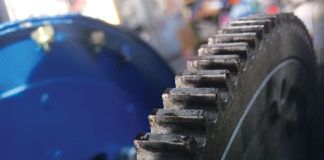Those of us lucky enough to have our own landing strips get to enjoy what many aviators can merely dream about. We check the flight conditions, walk out the back door, pull the airplane out of the hangar, preflight it and go. However, most of these private strips will be short, narrow and tucked into a small space. Surface maintenance, off-field obstacles, buildings, livestock, cross fences and other safety concerns must be continuously addressed.
To improve the consistency of my approaches, I installed a ball/bar visual glideslope indicator on my runway. Its patterned after the Shuttle inner glideslope indicator system and functions much like the Fresnel Lens Optical Landing System used by the Navy for carrier landings. A horizontal bar is placed some distance behind an elevated ball. On approach, the ball is lined up with the bar to achieve the proper glideslope. As a “fly-to” indicator, the ball will be above the bar if the airplane is below the glideslope, or the ball will be under the bar if the approach path is high (Figure 1).
Description
The Shuttle system uses a row of red lights for the bar and a cluster of white lights for the ball. Not needing night capability and with a desire for passive components, I elected to use no lights but rather a 3×8-foot panel for the bar and a 2×2-foot square for the ball. The ground cover next to my runway tends to be tan to light green, so I selected a white bar and black ball to provide the best color differentiation with the background.
As the distance (D) between the ball and the bar is reduced, the ability to see deviations is also reduced. I found that 24 feet between the ball and the bar is about right. The bar is slanted away from the approach direction. This does two things: The panel gets more light from the sky, and the pilot gets a more direct observation. I placed the bar about 15 feet from the runway edge and behind the ball, which is about 16 feet from the runway edge (Figure 1).
At visual acquisition, the ball will appear near the runway side of the bar. As the airplane flies down the approach path, the ball will seem to move away from the runway and toward the far end of the bar (due to parallax). An 8-foot bar, separated from the ball by 24 feet and which is 35 feet from the runway centerline, provides a visual background for the ball as close as 180 feet from it. For the white bar, I used a piece of metal roofing screwed to wood 2x4s and fastened to metal “T” fence posts (see photo). The bar is thus well anchored to resist movement by the wind. The black ball, 2×2-foot plywood, is similarly mounted and at a height (H) to yield the appropriate glideslope. H is the distance that the center of the ball is above the center of the bar (referenced to a horizontal if the runway is sloped).
Finding the Glideslope (H and D)
1. At a safe altitude, configure for a normal approach: flaps, rpm and indicated airspeed (IAS), and while holding these conditions constant, measure the time, in seconds, to lose 300 feet of altitude. (Note: Any test altitude is acceptable.)
2. Compute the sink rate for 1 minute by dividing 300 by the measured time and multiplying by 60.
3. Determine the test pressure altitude (hp) by setting the altimeter to 29.92 or with the following computation: hp = altimeter altitude + (29.92 – altimeter setting) x 940 (which is a fair approximation).
4. Using the outside temperature (Celsius) and hp, determine the density altitude (hd from Chart 1.
5. Using hd and IAS, determine TAS from Chart 2; assume IAS equals calibrated airspeed (CAS).
6. Using the distance (D), find the ball height (H) with the following:
H = D x sink rate TAS x 88 (TAS in mph) or H = D x sink rate TAS x 101 (TAS in knots)
Heres an example (See Chart 1):
1. Conditions: Altitude is 3800 feet, IAS is 60 mph, measured time is 25 seconds, altimeter setting is 29.71, temperature is 12 C.
2. Sink rate = 300 feet x 60 sec/min 25 sec, which equals 720 feet/min.
3. h
p = 3800 feet + (29.92 – 29.71) x 940, which equals 3997 feet.4. Input temperature is 12 C and hp is 3997 feet, yielding an hd of 4600 feet.
5. Input hd is 4600 feet and IAS is 60 mph, yielding a TAS of 64 mph.
See Chart 2 (valid for mph or knots)
6. If D = 24 feet, then H = 24 x 720 64 x 88, which equals 3.07 feet or about 3 feet 1 inch.
Flying the Ball/Bar
I try to be at a planned altitude as I cross a ground reference point some distance from the runway. In my case the reference is a road about 3300 feet short of the runway. The planned altitude is determined as follows: Planned altitude = H x distance to runway D, which is 3.07 x 3300 24, or 422 feet. I can see the ball/bar from about this position and usually only need small corrections to achieve the desired glideslope. If the ball is below the center of the bar, more power is needed to slow the descent rate and get back on course. At 2400 feet from the bar, I should be at 307 feet. If the top of the ball is at the top of the bar, I would be at about 250 feet altitude. This amount of deviation can be seen at a distance of 2400 feet. The H and D, as defined above, represent a no-wind situation. Any headwind will require a bit of power to maintain the proper flight path. When computing H, some headwind can be factored in by subtracting it from the TAS (for a steeper glideslope). However, on a no-headwind day, the approach will be too hot/high. (When initially using the ball/bar, be aware that some fine-tuning of its location and height may be required.) The ball/bar provides more consistency for setting up approach conditions than relying on visual judgment. Once on course, flying to the desired touchdown point is practically a matter of fact, a significant requirement for short runways. J





Hi Chuck
Thank you for great information on DIY Airport Glideslope Indicator. I have looked everywhere and you have been the closest I have found. I could not see the picture ?
Appreciate any help you can give me
Best Regards
Bill Houze
Any more info on a home made glide slope indicator?
I am interested in this project!